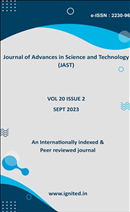Energy Recovery Potential and Environmental Impacts to Energy Recovery Options of Different Waste
DOI:
https://doi.org/10.29070/kr66h507Keywords:
Energy recovery potential, Environmental impacts, different wasteAbstract
This paper presents experimental models that predict the ages of biodegradable and non-biodegradable garbage by factoring in the residents' financial situation. However, while there are a number of models that can predict garbage age rates, none of them can independently predict biodegradable and non-biodegradable trash age rates for any given city using the readily available data related to economic factors. The financial factors utilized for the improvement of models in this study are family size, family pay, training, control of the head of families and fuel utilized in the kitchen. The exactness tests directed on the created biodegradable and non-biodegradable expectation models showed truly apparent outcomes with R 2 upsides of 0.782 and 0.676 separately.
Downloads
References
Arafat HA, Jijakli K and Ahsan A (2015) Environmental performance and energy recovery potential of five processes for municipal solid waste treatment. Journal of Cleaner Production 105: 233–240.
Björklund, A. (2020). Environmental systems analysis waste management. Licentiate thesis, KTH.
Katona Farnas, L. (2017). Analysis of energy recovery options of combustible demolition waste.
Kumar, A., & Samadder, S. R. (2022). Assessment of energy recovery potential and analysis of environmental impacts of waste to energy options using life cycle assessment. Journal of Cleaner Production, 365, 132854.
Lombardi L, Carnevale E and Corti A (2015) A review of technologies and performances of thermal treatment systems for energy recovery from waste. Waste management 37: 26–44.
Münster M and Lund H (2010) Comparing Waste-to-Energy technologies by applying energy system analysis. Waste management 30(7): 1251–1263.
Pandyaswargo, A. H., Onoda, H., & Nagata, K. (2012). Energy recovery potential and life cycle impact assessment of municipal solid waste management technologies in Asian countries using ELP model. International Journal of Energy and Environmental Engineering, 3, 1-11.
Porteous A (2005) Why energy from waste incineration is an essential component of environmentally responsible waste management. Waste Management 25(4): 451–459.
Rajput, R., Prasad, G. and Chopra, A. K., 2009. Scenario of solid waste management in present Indian context. Caspian Journal of Environmental Sciences, 7, 45–53.
Tchobanoglous, G., Thesien, H. and Vigil, S., 1993. Integrated Solid Waste Management, McGraw Hill Inc, New York.
Yadav P and Samadder SR (2017) A global prospective of income distribution and its effect on life cycle assessment of municipal solid waste management: a review. Environmental Science and Pollution Research 24(10): 9123–9141.






